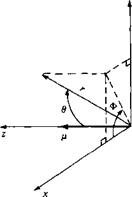Flow Over A Sphere
Consider again the flow induced by the three-dimensional doublet illustrated in Figure 6.3. Superimpose on this flow a uniform velocity field of magnitude in the negative
г direction. Since we are more comfortable visualizing a freestream which moves horizontally, say, from left to right, let us flip the coordinate system in Figure 6.3 on its side. The picture shown in Figure 6.4 results.
Examining Figure 6.4, the spherical coordinates of the freestream are
Vr = —Voo cos в [6.11a]
Vg = Voo sin в [6. lib]
Уф = 0 [6.11«]
 |
Adding Vr, Vg, and УФ for the free stream, Equations (6.11 a to c), to the representative components for the doublet given in Equation (6.10), we obtain, for the combined flow,
To find the stagnation points in the flow, set Vr — Vg = 0 in Equations (6.12) and
(6.13) . From Equation (6.13), Vg = 0 gives sin в = 0; hence, the stagnation points
![]()
|
are located at в = 0 and n. From Equation (6.12), with Vr = 0, we obtain
“•,51
where r = R is the radial coordinate of the stagnation points. Solving Equation
(6.15)
for R, we obtain
Hence, there are two stagnation points, both on the z axis, with (r, 6) coordinates
Insert the value of r = R from Equation (6.16) into the expression for V, given by Equation (6.12). We obtain
Thus, Vr = 0 when r = R for all values of в and Ф. This is precisely the flow – tangency condition for flow over a sphere of radius R. Hence, the velocity field given by Equations (6.12) to (6.14) is the incompressible flow over a sphere of radius R. This flow is shown in Figure 6.5; it is qualitatively similar to the flow over the cylinder shown in Figure 3.19, but quantitatively the two flows are different.
On the surface of the sphere, where r = R, the tangential velocity is obtained from Equation (6.13) as follows:
From Equation (6.16),
![]() fi = 27Г Я3
fi = 27Г Я3
![]()
|
Substituting Equation (6.18) into (6.17), we have
|
![]() [6.19]
[6.19]
The maximum velocity occurs at the top and bottom points of the sphere, and its magnitude is | V~^. Compare these results with the two-dimensional circular cylinder case given by Equation (3.100). For the two-dimensional flow, the maximum velocity is IVoq. Hence, for the same V^, the maximum surface velocity on a sphere is less than that for a cylinder. The flow over a sphere is somewhat “relieved” in comparison with the flow over a cylinder. The flow over a sphere has an extra dimension in which to move out of the way of the solid body; the flow can move sideways as well as up and down. In contrast, the flow over a cylinder is more constrained; it can only move up and down. Hence, the maximum velocity on a sphere is less than that on a cylinder. This is an example of the three-dimensional relieving effect, which is a general phenomenon for all types of three-dimensional flows.
 |
The pressure distribution on the surface of the sphere is given by Equations (3.38) and (6.19) as follows:
![]() [6.20]
[6.20]
Compare Equation (6.20) with the analogous result for a circular cylinder given by Equation (3.101). Note that the absolute magnitude of the pressure coefficient on a sphere is less than that for a cylinder—again, an example of the three-dimensional relieving effect. The pressure distributions over a sphere and a cylinder are compared in Figure 6.6, which dramatically illustrates the three-dimensional relieving effect.













